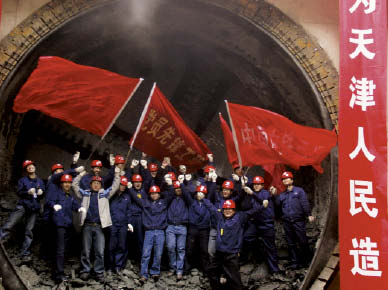 Presently, Tianjin subway line 2, 3 and 9 and Beijing subway line 4 and 14 are under construction. Upon their completion by 2010, they will link to Tianjin Station and South Beijing Station respectively, making possible “seamless link” between the two municipalities. At that time, inter-city railway plus underground will be the best travelling choice for people commuting between the two cities. Presently, Tianjin subway line 2, 3 and 9 and Beijing subway line 4 and 14 are under construction. Upon their completion by 2010, they will link to Tianjin Station and South Beijing Station respectively, making possible “seamless link” between the two municipalities. At that time, inter-city railway plus underground will be the best travelling choice for people commuting between the two cities.
A lot of Tianjin people have special affection towards the old Tianjin subway. The old subway refers to the first-stage construction project of Tianjin subway line 1, which began construction in 1970 and went into service in December, 1984. It is the second underground (the first is Beijing Subway) built in China, with the length of 7.4 kilometers and eight stations of different architectural styles.
Since the operation of the old underground, it had been transporting 20,000 passengers daily on average and improved Tianjin’s urban traffic to some extent. In November of 2002, the new Tianjin underground line 1 project and the reconstruction of the old underground started. In the year of 2007, Tianjin underground line 1 went into service, and taking the subway gradually became the major method for urban transportation. Subway line 1 and Tianjin-Binhai Light Rail are 71.6 kilometers in length, with a daily passenger flow of 130,000 people.
As an extension of the original underground, subway line 1 crosses the central part of Tianjin, spanning 26.2 kilometers including the original 7.3-kilometer section and the newly built 18.9-kilometer part.
In order to build the underground network as soon as possible to allow the track transportation network work efficiently, construction on subway line 2, 3 and 9 started in 2006. It is estimated that the construction of line 2 and line 3 will be completed by the end of 2009. Subway line 5 and line 6 are also under preparation, and the construction is expected to start at the end of 2009. The subway lines will provide a “seamless link” between Tianjin Railway Station and Beijing-Tianjin Inter-city Express Railway, making it more convenient for people to travel between the two cities.
In 2006, while endorsing the Tianjin City General Plan (2005-2020), the State Council defined the future Tianjin as an international port city, economic center of North China and an eco-city as well. Since then, Tianjin’s urban infrastructure has developed rapidly.
Tianjin proposes to push ahead the strategy of developing public transport as the priority, allowing the underground track transportation to better play its role in the city public transportation. The future city public transport will be supported mainly by mass transit track system and regular bus, supplemented by taxi and other transport methods. The urban rapid rail transit network has been planned.
Presently, the central districts of Tianjin plan to build nine underground lines and there will be one light-rail line from the central district to the Binhai New Area. Among them, subway line 1, 2 and 3 are the main lines penetrating the city center; line 4, 5 and 6 are the inner supplementing circle lines going through the down town area; line 7 and 8 are the outer supplementing lines while line 9 is the urban section of the Tianjin-Binhai Light Rail.
A range of advanced technologies are extensively adopted in constructing Tianjin subways, endowing it the characteristics of being energy efficient, environmentally friendly, secure and highly automatic. For example, platform shielded gate is adopted in all stations, ensuring the waiting passengers’ personal safety, reducing noise and therefore improving the environment of the station.
By 2010, subway line 2 will be ready to operate, and preparation for line 3 will finish by the end of June, 2011. The full length of track transportation will reach 52 kilometers and will effectively relieve the ground traffic pressure, allowing passengers to reach their destinations rapidly and punctually. It will also better support the economic development and people’s life. |